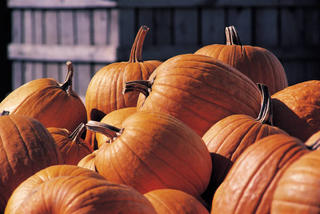
PUMPKINS have long had a culinary fascination for me, particularly around Halloween. It started when my father would recycle our jack o’lantern into pumpkin pie complete with a homemade crust. It continued after college with my almost ritual serving of a rich, custard cheese casserole prepared inside a pumpkin shell at Halloween. When my kids were younger, my creativity flourished as I helped to create such pumpkin favorites as surfer dude pumpkin and diaper baby pumpkin (my kids were not that into scary, I guess.) Now, I tend to explore the many high fiber, low calorie variations pumpkins provide.
IN A PUMPKIN SHELL – Weight watchers tend to really be excited about pumpkin’s lack of calories not to mention fat. The thrill could be because of its association with pie and whipped cream. Four pounds of whole pumpkin (with seeds and peel) will equal about two pounds of raw flesh. One pound of raw, peeled pumpkin yields about four cups of chunks or two cups of cooked puree. I’ve cooked with both fresh and canned and there is no question fresh is better, but canned puree is a quick, healthy convenience food. Just look for cans containing only one ingredient – pumpkin – and avoid those labeled “pumpkin pie filling.”
TRICK OR TREAT – The bad news is that most of the pumpkins you see in the market are field pumpkins, great for jack o’lanterns, a bit stringy and watery for eating. Look for “sugar pie” or “cheese” pumpkins or any other variety labeled “cooking pumpkin.” Sugar pie is probably the most readily available. Check with your local produce market or manager for availability. The cheese pumpkin is reputed to be the pumpkin first canned for pumpkin pie. Cooking pumpkins have a denser, sweeter flesh than field pumpkins. No matter what kind of cooking pumpkin you use, select one that is bright orange and seems heavy for its size with its stem attached. Whole pumpkins keep a month or more if stored in a cool room. Raw chunks can be refrigerated for a few days and cooked puree freezes well.
USER’S GUIDE – To prep a pumpkin, start like you are going to make a jack o’lantern. Cut open at the “lid.” If you are going to peel the pumpkin to use raw or to steam, use a sharp knife and trim away the outside peel, then cut the pumpkin shell in half vertically. Leave the skin on if you will be baking the pumpkin. Scoop out the seeds and strings with a tablespoon. To use raw, cut in chunks and add to soups, stews, sautés, curries and chilis. To use as a puree, choose steaming or baking (which I think results in a sweeter, less watery puree). For steaming, cut in 1 ½-inch cubes, place in steamer basket over boiling water and steam for 15-20 minutes or until tender. Drain well before pureeing. To bake, place pumpkin halves cut side down on an oiled baking tray. Bake at 350 degrees for until the pumpkin flesh is tender when pierced with a fork. Discard peel before using. One advantage of making your own pumpkin puree is that you can make it as fine or chunky as you like. I like a bit of chunk in most recipes for texture. Pump up vegetable soup by adding one to two cups of pumpkin puree along with some fresh minced ginger, a pinch of red pepper flakes, a half teaspoon or so of coconut extract and possibly some leftover, chopped steamed greens and two tablespoons of smooth peanut butter.
No comments:
Post a Comment